We take a look at the 29 most common ELECTRICAL PROBLEMS IN HOUSE that can occur in and around the home, what may be causing them and what we can do about them.
Índice
- Tripped Circuit Breaker
- Dead outlets
- Faulty switches
- Flickering Lights
- Overloaded Circuits
- Warm Outlets or Switches
- Buzzing Noises
- Tripping GFCI or RCD outlets or switches
- High Energy Bills
- Sparking or Arcing
- Electric Shocks
- Dimming Lights
- Intermittent Power Loss
- Outdated Wiring
- Malfunctioning Appliances
- Damaged Cabling
- Corroded Wiring or Accessories
- Inadequate plug sockets
- Loose light switches
- Loose plug sockets
- Bad Earthing – What is it?
- Faulty Smoke Detectors – Are these an electrical problem?
- Incorrectly wired plug sockets
- Exposed Wires
- Faulty Extension Cords or Leads
- Water Damage
- Faulty Outdoor Electrics
- Loose Connections
- Incorrectly Wired Switches
- Frequently asked Questions...
Some of these problems will be solvable by some detective work and some will absolutely require an electrician.
Why 29? Well, that just how many it turned out to be, ok? 😊
It’s important to know when to call an electrician as electricity is a dangerous force that requires respect, knowledge, and competency in order to handle it and work with it safely. A professional will have the right tools, knowledge, qualifications, and experience to carry out electrical work.
Back to top1) Tripped Circuit Breaker
A tripped circuit breaker is one of the most irritating and common problems that we will face in the home electrical system. Many customers call me up out of frustration following a circuit breaker problem and tell me they need a new circuit breaker because it won’t turn on.
In reality, the most likely cause of a tripped circuit breaker is actually an electrical fault on the circuit that the breaker is protecting. These circuit breakers are designed to protect the wiring in our homes and as such, when they detect an issue with the wiring or with anything that may be connected to the electrical circuit, they are designed to shut off the electrical supply to prevent damage, fire, or electric shock.
There are different kinds of circuit breaker devices which provide different functions and protection to the user. Each kind of circuit breaker may trip for a different type of fault, that’s right, there are many different issues that can cause a switch to trip!
One of the ways you can investigate a tripped switch yourself is to follow our helpsheet for advice. This may mean that you don’t need to call an emergency electrician out to help, or at least save you some time and money.
Back to top2) Dead outlets
The issue of dead outlets is a common problem especially in older homes or older wiring systems.
If an outlet appears dead, take great care! It is possible that the outlet is still in fact live but is not functioning correctly. This is one of those situations where calling an electrician might be best as apparently dead electrics have caught out the best of us at times and the risk of electric shock, burns or injury is never worth it.
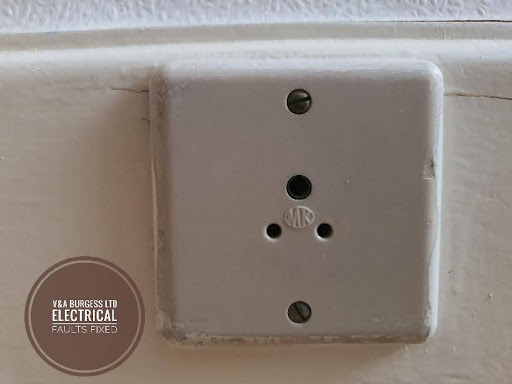
(Old outlet that is now dead)
Loose wiring can mean that an outlet might not work correctly but is still HOT or LIVE and dangerous. When a Neutral wire comes loose, the circuit will no longer work correctly BUT the outlets will be LIVE whilst looking DEAD. It’s not as complex as it sounds.
Loose wiring can also lead to burnt out outlets which can mean that they no longer work correctly AND need replacing for safety reasons. This can lead to damaged cables as heat travels down the cabling and melts the insulation!
There are of course occasional electrical problems that may mean an outlet has to be disconnected and rather than disruptive repair works being carried out, some homeowners opt for disconnection to save money and disruption. This can be frustrating for you if you have just purchased a property and have discovered that the previous owners have left you with some problems.
Back to top3) Faulty switches
Light switches get an absolute hammering in our homes, especially in those areas where there is a lot of foot traffic. The need to save energy and reduce spending on energy bills means that more of us than ever are turning off the lights continually when leaving a room and back on again when we return.
Saving energy is an absolute priority for everyone and of course the cost savings too! The counter problem is an increase in wear and tear on our home electrical system and in particular light switches. Every light switch has a lifespan of operations that it will withstand before failing. Light switches contain moving parts which are subject to wear and tear as the mechanism slides together and apart to make contact and close the electrical circuit providing light to each area in our home.
The switch mechanisms can become ‘spongy’ and the front part / rocker of switches can even become detached, falling off and leaving access to live parts.
Wire connections at the terminals on the rear of switches can become loose and cause lights to flicker, switches to heat up, shorting out to occur in the box at the rear and other problems.
The light switch in the photograph below was metal and did not have the earth connected!!!! This is a vital feature with metalwork in electrical systems and the earth / ground must be connected.
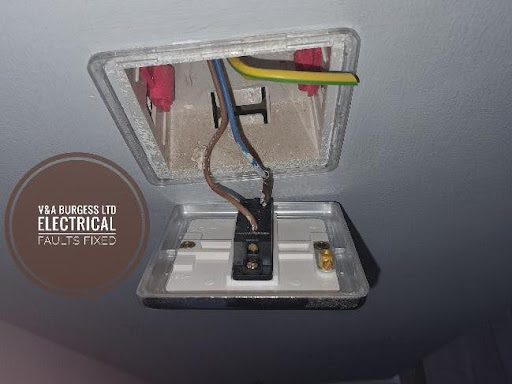
Changing a light switch can be straightforward and can also cause absolute chaos depending upon how the lighting system in your home is wired. A lot of homeowners expect to see two or three single wires and occasionally there is a surprise where lots and lots of cables enter the rear of the light switch. Replacing a broken light for light switch can be a quick easy job and can sometimes be safely performed by a homeowner as long as the correct procedures are followed.
I would always recommend that you find yourself an electrician to carry out this kind of work for you. If anything should go wrong, the job should become more complex or any other unforeseen issues should occur, the electrician is usually well equipped and stocked with parts to solve the issue there and then.
Back to top4) Flickering Lights
Flickering lights can be a real concern to many people. I understand this myself as flickering lights can be indicative of very serious electrical issues which can lead to fire or electric shock risk. By the same note, flickering lights can also be absolutely nothing to worry about and can sometimes be solved very quickly and cost effectively. It depends on the reason for the flickering lights. 😊
There are different electrical issues that will cause flickering lights. The general problem is an intermittent electrical supply to the lamp / bulb which causes it to flicker. This intermittent electrical supply can be as a result of lots of different issues. There is a whole article on flickering lights if you would like to know more so check it out and get in touch if you have any questions.
Back to top5) Overloaded Circuits
Overloaded circuits are less common than they actually used to be, or at least, that’s partially true. Lighting circuits now tend to be rarely overloaded as most electrical systems now use incredibly low power consumption LED lighting as opposed to the filament or halogen style lighting of decades gone by.
Other circuits are more susceptible to overloading however. When natural gas boilers fail and we switch to electric heaters, our plug socket outlets cannot always take the strain and it is easy to overload the circuit quickly. Electric shower circuits are often a cause for overloading and failure as they fall victim to frequent loose connections, overheating and melting of electrical terminals.
Car charging circuits are a potential source of overloading as they tend to draw a very large amount of power. If correctly designed and installed, the chances of this are slim and with the ever-improving charging box technology, the equipment is becoming more intelligent and will often shut off supply if it senses a problem.
The issue of overloaded circuits in general tends to be one of user error rather than initial design flaw. Electricians and designer will create and install electrical circuits that are unlikely to become overloaded for their intended use. It is normally only when external factors create additional load that circuits tend to suffer. If for example, the electric oven was to fail then additional load could be placed on the plug socket outlets by using other cooking equipment which could lead to an overloaded circuit.
Back to top6) Warm Outlets or Switches
Electrical systems increase in temperature during use due to the current flowing through cables causing the copper or aluminium metals to heat up. A small general increase in temperature is perfectly normal and should not give any cause for concern.
What happens when things get too warm or even hot?
This could indicate that there are problems in the electrical installation with the wiring, the connections or the electrical equipment that is being used. Electrical equipment should generally not become hot to the touch or give off any funny smells. If this happens then there is likely to be issues that require investigation. If you find that you are having overheating, strange smells or discolouration from anywhere in the electrical system then it’s best to call a professional immediately in order to investigate the problem for you. These kinds of ELECTRICAL PROBLEMS IN HOUSE could well lead to burns, fire, or other property damage.
Back to top7) Buzzing Noises
Buzzing noises from the electrical system can cause many customers to worry about the safety of their electrics. There are certain circumstances where buzzing noises are ok or even normal and other circumstances where these noises are an indication of problems occurring in the electrics.
A doorbell transformer is likely to give off a quiet buzzing sound under operation. This is due to the changing of one voltage to another. The process is not complete 100% efficiently and the energy losses are through sound and heat. This would also explain why a doorbell (or indeed any) transformer is likely to become warm during normal everyday operation.
Various appliance transformers for equipment used around the home will also heat up as they transform one voltage into another.
Dimmer switches can cause a slight buzzing to be heard during operation. Louder buzzing sounds from these switches can indicate that there may be an incompatibility with the switch, the size of the electrical load and the lamps that are connected. The buzzing noises can sometimes be heard at the electrical panel through the circuit breaker that supplies the lighting circuit. These noises should be investigated by a professional to ensure that everything is operating normally and there are no incompatibilities with equipment.
8) Tripping GFCI or RCD outlets or switches
When a Ground Fault Circuit Interrupter (GFCI) or Residual Current Device (RCD) trips power off, it is normal to assume that there may be a problem with the actual device itself. In reality, it is more common to find that the issue lies with the equipment or circuit that the device is monitoring and protecting.
GFCI and RCD devices will occasionally fail after being reset many times or lock up after never being tested but generally these devices will fail less commonly than circuit problems occur.
Various circuit conditions will cause these devices to trip, moisture ingress, cable damage, rodent attacks on electrics, faulty appliances and melted terminals in electrical accessories are all common causes for these devices tripping. Should you have a GFCI or an RCD that is tripping continually or occasionally then it is normally best to have an electrician inspect the wiring and circuit to ascertain the cause.
Not all causes will show upon testing and some investigative work is sometimes necessary in order to pin down the actual issue, if the device trips continually then the fault is usually still present in the system and finding this become easier.
Back to top9) High Energy Bills
High energy bills have hit everyone hard across the world in recent years. Many businesses have suffered especially and some have had to close down as a result or spiralling energy costs that cannot be met by increasing prices to consumers.
In our homes, we also have had to bear the costs of ever-increasing Gas and Electricity prices and many of us have struggled to keep up, but when do increasing energy bills indicate that excessive consumption or faulty equipment may be the cause rather than unit costs increasing? First of all, check out our quick guide to reducing your energy bill.
If you suspect that your consumption is not adequately reflected in your bills then it may be worth keeping an eye on your consumption yourself. Check to see if smart (or non-smart) meters are reading correctly, keep a record of your electricity and gas usage and compare this with the unit costs for your bills. Ask your energy providers to check if their equipment is working correctly, faulty metering equipment could result in high energy bills being charged when, in fact, equipment may have malfunctioned.
Old electrical wiring and fuse box / electric panels can lead to higher energy bills. If excessive electrical current is disappearing from the system, then energy bills can increase. This also extends to faulty appliances. Where earth leakage occurs (electrical current leaking away to earth) electricity can be used even when you think you are not using anything!
Old electrical appliances are also not as energy efficient as newer varieties so will undoubtedly use more energy and cost you more money. This is especially prevalent during the winter where everybody’s energy costs rise as they use more heating and drying equipment.
Back to top10) Sparking or Arcing
Electrical sparking or arcing is where electricity jumps through air from one electrical point of contact to another. The resultant noise unmistakablele and is very similar to that of a welder (if you have ever heard that sound before). Arc welding is a similar process albeit safely controlled.
The temperatures reached during electrical arcing can be very high and can cause electrical cabling, accessories, and terminals to melt or catch fire.
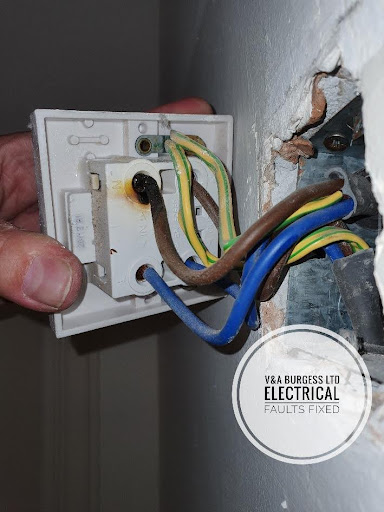
(Photograph showing loose connections and arcing leading to overheating)
Loose connections, cable damage and faulty appliances can all cause electrical arcing and if you suspect that you have electrical arcing or sparking happening in your home then a professional should be called immediately to investigate the situation, I would never advise attempting to repair electrical problems such as this without professional intervention.
Back to top11) Electric Shocks
I would hope that your immediate response to electric shocks would be to call a professional. Static shocks on the other hand can occur within the home and are normally nothing to worry about.
Common causes for electrical shocks in the home are problems such as, poor earthing to the street, poor earthing on internal electrical circuits in the property, old wiring, faulty appliances, incorrectly wired socket outlets or other electrical equipment and various other issues.
In modern electrical systems, there are device that protect us from electric shock such as the GFCI and RCD devices mentioned earlier. These devices will detect when there is missing electrical current from a circuit or bunch of circuits and will disconnect the power to those circuits once the missing current reaches a preset threshold. The threshold is set lower than the quantity of electrical current that would cause serious harm or worse for obvious reasons.
We would like these devices to work correctly and to be installed in the first place. If your home does not have these devices installed then it is a great idea to have your electrician install them for you. If you do have these installed then it’s also a great idea to have these devices checked every few years by a professional with the correct test equipment to ensure that they are still functioning correctly.
The photograph below shows an emergency situation I was called to where the metalwork in the property was live!
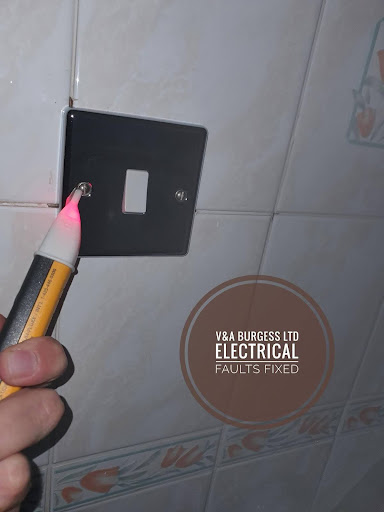
If you are experiencing shocks from the wiring or metalwork in your home then there may also be electrical issues that are outside the home from the supply. Regardless, electric shocks should be investigated by a professional ONLY.
Back to top12) Dimming Lights
Dimming lights are not only irritating but can be a cause for concern. When lights dim intermittently, this can be as a result of heavy equipment locally that is starting up such as commercial motors, industrial demand or even a very slight and rapid dim when you switch on the vacuum cleaner. This type of quick, barely noticeable dim is often not a cause for concern and is a result of a voltage drop due to high starting currents from motors. The issue is gone as quickly as it came and doesn’t necessarily mean that you have problems.
A longer period of dimming lights or intermittent dimming lights can indicate that there are more sinister issues at play. Loose wiring somewhere in the electrical system would cause the lights to dim, especially when there is more electrical demand such as powerful appliances or lots of equipment turned on. If you are frequently experiencing dimming lights then it is a good idea to have an electrician out to check these ELECTRICAL PROBLEMS IN HOUSE for you. The sooner electrical issues are discovered, the less likely there is to be permanent damage or expensive problems that require repair.
Back to top13) Intermittent Power Loss
When there is intermittent power loss there can be problems with the supply to your home or within your homes electrical system itself. Commonly there can be issues in the street supply which may well be under the surface of the concrete or tarmac outside. If this is the case then the electricity network provider should be called to repair the problem.
As a homeowner you may not know if this is actually the problem or if the problem lies inside your homes electrical system itself. In order to find out if there is a problem in the street you should contact your local electricity supply authority. The contact details for this will vary depending upon where in the world you are.
In the UK, call 105 freephone which will put you through to your local Distribution Network Operator. Once you get through the menus you will be asked for your address and a description of the issue. They will let you know if there are any planned works in the area or any works happening presently that are affecting your supply. You can check their website also.
In the US there is help and advice available for what to do in a power cut situation. If you want to check if there is a power outage in your area then call your local utility company. You can find their number by performing a quick internet search.
What if the problem is not in the street?
If you find out from the local supplier or network provider that there is no problem in the street then you need to call a local fault-finding emergency electrician. The electrician will be able to narrow down the problem and find out why there is an intermittent power cut in your home.
Common causes of intermittent power cuts in your home are:
- Loose connections on the incoming supply.
- A failing main switch in the electrical panel or consumer unit.
- Loose wiring in the electrical panel or consumer unit.
- Problems with the mains supply fuse.
- Burnt out cables.
14) Outdated Wiring
When wiring is outdated it can create problems in your home. From flickering lights to intermittent power failures, old wiring should be checked out to make sure that there are no electrical dangers and that the system is suitable and capable of supplying the power for your needs.
Not all outdated wiring necessarily needs to be replaced however, just because something is old does not mean it is no good. The issues arise when age is accompanied with a lot of wear and tear or the desire to extend the property, modernise or renovate. When carrying out renovations wiring is often required to be moved, extended or in some way altered. In these circumstances it is highly likely that an aging wiring system will need to be brought up to date in order to comply with local building and wiring regulations.
As wiring ages, the insulation around the copper or aluminium wires begins to degrade. This can lead to electrical current leakage causing GFCI or RCD devices to trip and can also lead to shorting out. These two issues can lead to further cable damage and eventually necessitate replacement. It’s always best to get a thorough electrical check carried out before considering any renovations.
Back to top15) Malfunctioning Appliances
We would all like our appliances to last forever and therefore represent incredible value and reliability but unfortunately those days have gone. I remember being a kid and seeing a 30-year-old refrigerator that was still going in my parents’ kitchen but seldom do appliances make it to that age these days.
When appliances begin to go bad, they can develop electrical faults such as earth faults, ground faults and short circuits within the electronics and internal wiring. When this occurs you will find that the fuse for the appliance may blow or the electrical panel / consumer unit will trip causing a potential headache as you try to find out what is causing the problem!
One of the most common causes of the electrical panel tripping is actually faulty appliances so it’s often a good idea to start with unplugging all the items that are plugged in around your home to see if this allows you to reset the trip switch. Our handy guide goes into more detail.
Back to top16) Damaged Cabling
When cabling is damaged, modern electrical systems can often detect this. The damage does have to be sufficiently severe (mouthful sorry) in order for the electrical panel or consumer unit to pick it up, but nevertheless it will detect the issue for you and shut off the affected circuit or group of circuits.
Cable damage is typical in places where high traffic or certain activities go on. The home garage is typical for witnessing cable damage and if cables are not sufficiently protected from damage, then accidents can occur.
In the UK the most common form of cable found in the home will be 6242y or ‘twin and earth’ cable. This is usually grey or white in colour and is a flat sheathed type cable with a Line conductor, an unsleeved Earth (circuit protective conductor) and a Neutral conductor. Colours are either red / black for older cabling pre 2004 or Brown / Blue for more modern cabling. When this type of cable is installed, it is meant for installation in areas where it is not likely to be damaged such as:
- Safe wiring zones.
- Under floors.
- In lofts or attic spaces clipped out the way.
This type of cable cannot normally survive a sharp or blunt impact without visible external damage or internal insulation damage. A more suitable cable for the garage environment would be a tough sheathed cable or possibly a steel wire armoured cable. Twin and Earth can be used but is often best when installed in to conduit or trunking offering some protection against impact.
Damage cabling is one of the most common reasons for a customer to request an emergency electrical call out to check their homes wiring.
17) Corroded Wiring or Accessories
When corrosion occurs in electrical accessories the electrical contacts suffer and as a result become less conductive. What do I mean? The point of electrical contact become less able to pass electrical current between one point and another if there is rust or corrosion in the way. This leads to heat build-up from the excessive resistance and then a vicious circle of heat and resistance until ultimate failure.
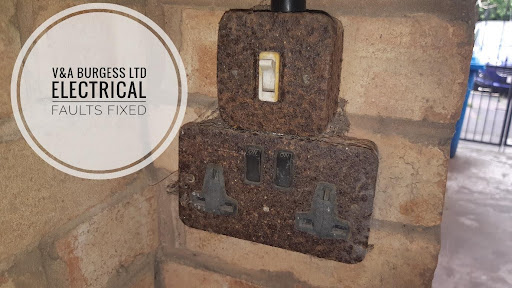
The best way to avoid this type of problem is to ensure that the electrical accessories are suitable for the environment in which they are installed. This sounds straightforward but is often the downfall of an otherwise great electrical installation. 😊
Installing indoor plug socket outlets outside is a no-no, using metal sockets in an environment where there is excessive moisture is just begging for rust and corrosion to occur. Wiring can become corroded in moist environments as well increasing its aging process and resulting in wiring that is not as conductive and inefficient.
The process for resolving the issue of corrosion is normally to tackle the cause of the moisture ingress into the electrical system and then establish the damage that has been done along with a plan to repair it.
Back to top18) Inadequate plug sockets
Not one of the worst ELECTRICAL PROBLEMS IN HOUSE but certainly an issue. When there are an inadequate number of plug sockets in the house there is a general overreliance on extension leads to power all the necessary equipment. It is very easy to overload an extension lead and as such this can lead to danger.
To ensure you are not relying on extension leads in an unsafe manner, check out the extension overload calculator on the electrical safety-first website. Their website is an invaluable resource for everything electrical related.
If you find that you have an insufficient number of plug sockets or socket outlets in your home then it may be an idea to have an electrical inspection carried out to ascertain the age and condition of your wiring system. This is a good idea before extra socket outlets are added in any case but especially when the system has not been inspected for over 10 years.
Older wiring systems tended to have very few plug sockets in all the rooms so if you find that you have very few or not enough socket outlets then it is possible that your wiring system may be quite old. An electrician is the suitable person to perform a technical electrical inspection.
Back to top19) Loose light switches
Loose light switches are not an electrical fault themselves but they are a danger to those using the electrical system in the property. If the light switch is loose then it needs to be tightened or re-secured in some way. This can sometimes be safely carried out on a DIY basis. Ensure that all the power is turned off at the main electrical panel or consumer unit and ensure that SAFE ISOLATION procedures are followed (example in best practice guides) along with using the correct GS38 approved voltage detection equipment.
It may be possible to now tighten the electrical screws holding the light switch in place. Electrical screws are typically 3.5mm machine screws, they should not be wood screws or another type of screw as these can introduce danger. If the screws will not tighten then it may be best to employ the services of an electrician.
Screws that will not re-tighten indicate that the back box that holds the wiring and the light switch in place needs repair. Re-threading, new lugs and general back box repairs are often best left to an electrician whom has the tools and equipment to carry this out quickly and efficiently for you.
Back to top20) Loose plug sockets
Just as with loose light switches, a loose plug socket can introduce danger in to the home and those using the electrical system. Possibly more so than a loose light switch as plug tops are inserted and removed from plug socket outlets regularly. This carries a greater risk of further damaging or loosening the plug socket from the wall and as such, repairs should be carried out without delay.
Just as with a loose light switch, a loose back box may have broken or damaged lugs or plastic retaining clips and require repair or replacement. Whilst it may be possible to carry out the repair on a DIY basis, by the time the necessary tools and parts have been purchased along with the time taken to safely reinstall the plug socket and risk of damaging cables…. It might just be easier to get a professional in to carry out the task.
The socket outlet below has been wallpapered into the wall and plastered in, there is no easy way to ever replace this without causing a great deal of damage. This is a poor DIY attempt unfortunately.
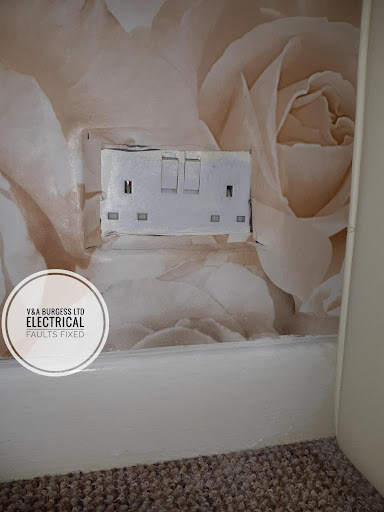
If you are adamant that you will be carrying out the repair yourself, please check the link just above to ensure that safe isolation procedures are followed and the right equipment is used to confirm the circuit is dead.
Back to top21) Bad Earthing – What is it?
You may have heard the term ‘bad earth’ before but what does it actually mean?
A bad earth can be used to describe an earth connection that is either non-existent or is faulty in some way. This could be a higher-than-normal resistance that has been measured meaning that the safety of the electrical system has been affected or is at risk or it could be that the earth is undersized and may not be able to handle any electrical fault currents that appear under fault conditions.
Sometimes, bad earthing can be a missing earth on one or more electrical circuits in the electrical system. When this happens, it is possible to receive electric shocks from metal work around the home. Electrical currents that would otherwise be carried away may sit on metalwork waiting for a path to earth as one has not been provided. YOU become the path to earth for these voltages and currents sat waiting for you.
Bad earthing is DEFINITELY a job for an electrician and not something that should be repaired on a DIY basis. Sophisticated test equipment, experience, and knowledge of the relevant sections of the wiring regulations is required in order to ensure that electrical system earthing is safe and meets the requirements of any safety legislation.
Back to top22) Faulty Smoke Detectors – Are these an electrical problem?
Possibly not but certainly worth a mention as many modern smoke detectors, heat detectors and carbon monoxide detectors now require that a permanent electrical supply is provided to them. Sensible really as how many times have we all forgotten to change the batteries in these things?
When the electrical supply to these items is affected, they can beep incessantly and cause havoc. If changing the batteries does not work then it’s time to call an electrician. Some brands of smoke detectors almost require a degree in fiddly electronics to remove from the ceiling but your electrician will no doubt have taken these down to fix them many times before.
If in doubt, check the manufacturer’s instructions or website to see how they come off the ceiling mounts before breaking them completely. 😊
23) Incorrectly wired plug sockets
This is one of the most common mistakes that is made by your average DIY enthusiast. The trouble is, sometimes, the socket will continue to work even if it is wired backwards or missing an earth connection. This is why incorrectly wired plug sockets can be absolutely deadly. As an electrician myself I would always recommend getting a professional in to tackle any electrical work in and around the home for a few reasons:
- They are trained and insured.
- They know what they are doing.
- They will carry out electrical tests to ensure safety is maintained.
- They will do the job three times quicker than you and without damage.
- You will likely get a certificate for most electrical jobs to prove it’s been done right!
There is also the issue of your home insurance. I’m pretty confident that most insurers take a dim view of DIY electrical work, especially that which has been done poorly! I have carried out many emergency calls over the years for different home insurers and a common theme that crops up is poor installation work. Guess what? If it’s done badly, it’s not done in accordance with the wiring regulations and therefore it is NOT going to be covered!
If you have incorrectly wired sockets, you may not realise until there is a secondary problem and your electric shock protection or circuit protection is rendered useless and the electrical panel or consumer unit does not detect the issue due to incorrect wiring. Then you have REAL problems. ☹
Back to top24) Exposed Wires
I would hope that this is a mostly obvious one. If you can see exposed cables then they are not necessarily unsafe but in certain circumstances they can be.
- If wires are dangling around unsecured, they are potentially dangerous.
- If there is any colour of insulation visible and no sheath on the cable then it is potentially dangerous as live parts are nearly accessible.
- If the cable is damaged then it is potentially dangerous.
- If there are any burn marks or discoloration on the cable it could be dangerous.
If you are unsure of what constitutes an electrical danger then it’s best to contact your local trusted electrician and ask their advice. We are always happy to help you if you are in the UK as we are more than familiar with the UK wiring regulations and safety procedures. If you are anywhere else in the world then find your local electrical specialist and ask. 😊Our advice service is always free and where we can we will recommend a local specialist to you.
Back to top25) Faulty Extension Cords or Leads
These things get absolutely wrecked over the years! Extension leads are one of the major causes of electrics tripping in the home and I have lost count of the amount of emergency calls that have resulted in finding a faulty extension lead. Not only are they often a trip hazard but they are regularly used as permanent supplies to equipment that should have had its own plug socket outlet installed or dedicated supply.
I have found extension leads wrapped in plastic bags supplying sheds outdoors, extension leads attached to more extension leads supplying lots of different equipment and even an extension leads supplying TWO, YES TWO electric heaters. Check the picture, the plug socket melted, the extension lead melted and thank goodness the electrical panel / consumer unit was modern as it detected the issue and tripped before a nice fire really got started! ☹

26) Water Damage
As a regular insurance electrician, I see many a case of water damage to electrics. As I’m sure most of you will know, water and electrics DO NOT MIX and certainly do not play nicely together.
Water ingress into electrical cables causes the insulation to degrade immediately and, in some cases, permanently which effectively ruins the cables. Should the circuit protection in the electrical panel be old then the damage can be much more severe to cabling. Modern circuit protection will often save the cables quicker resulting in less damage and less expense to put right the problems after the leak has been fixed.
Water ingress into electrical accessories such as switches, lights and socket outlets will often mean that these are ruined and need to be replaced.
Water ingress into an electrical panel / consumer unit is just going to be expensive. Sorry folks, it’s true. Electrical panels and consumer units cost money and time to replace and water entering the cabling and switchgear in these panels just ruins everything. I don’t know an electrician that is happy to ever switch this stuff back on after a good soaking and I certainly wouldn’t ever do that and tell a customer “It’s all good”.
Installing electrical panels in rooms below pipework and bathrooms is a bad idea to start with as eventually there will be a leak. Once again, water ingress into electrical systems is a problem that is best solved by a roofer, plumber then an electrician and certainly not something that you should consider tackling yourself.
Back to top27) Faulty Outdoor Electrics
Outdoor electrics are constantly at the mercy of the rain and the other elements. Constant sunlight can degrade plastics to the point of complete brittleness where the slightest knock will shatter the plastics. In the United Kingdom I see a great deal of water entering electrical equipment that is installed outdoors. If we look at the photograph below, we can see that this specially designed outdoor rated ‘waterproof’ electrical box housing an electrical extension lead has failed and the electrics are absolutely swimming under water. I think this was mostly user error but at least the customer and I had a chuckle whilst I restored her power for her.
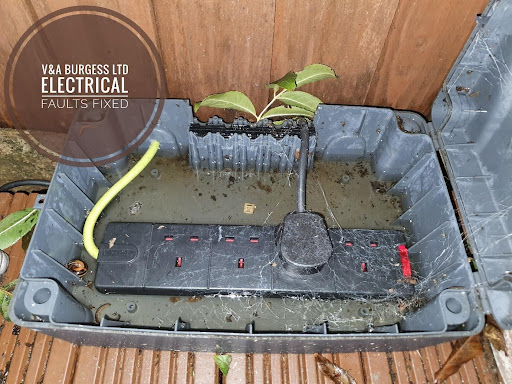
28) Loose Connections
Commonly found in aging electrical installations where no inspection or testing has been carried out for a long time.
Why do electrical connections become loose?
Our electrical supply is 60hz in North America or 50hz in the UK. This means that 50 or 60 times a second, the supply current is alternating back and forth. This results in a tiny vibration on the cables.
When electrical current passes through cables, the metal expands and contracts as it heats and cools. Electrical connections at the back of switches and socket outlets also heats and cools, expands and contracts. As these metals are different, they will expand and contract at different rates too.
This heating, cooling, expansion, contraction, vibration, and other movements all lead to loose connections occurring over time. This is one of the major causes of overheating, high resistances and burning out of electrical accessories and wiring.
Then of course, we are assuming that the electrical connections were correctly installed to begin with to the manufacturers recommended torque setting. Connections that are too tight to begin with can cause stress fractures in the metals that are exposed to the torque and this can lead to prematurely failure, cracking and breaking of the cables. Exciting stuff, eh? 😊
Back to top29) Incorrectly Wired Switches
When switches are wired incorrectly, they can introduce danger into the electrical system. Switching a Neutral instead of a HOT or LINE wire can result in danger for example a light fixture appearing to be dead when in fact it is permanently live and only manages to function when the Neutral is completed at the switch.
The light fitting will still appear to work as intended but nevertheless the danger is there.
Incorrectly wiring other types of switches can also introduce danger into electrical systems. Switches in the electrical panel / consumer unit need to be wired in a certain manner in order to ensure that safety features work as intended. The torque on the connections needs to be correct to ensure they are tight enough but without damaging equipment or cables.
Fuse switches are also vitally important to wire correctly!
These jobs are best left to electricians that understand wiring systems and local wiring regulations.
Back to top30) Frequently asked Questions...
30.1) When should I call an electrician?
Almost any electrical task requires the assistance or intervention of an electrician although there are some tasks that can be performed on a DIY basis with the right tools, equipment, and knowledge.
Certainly, if there are switches tripping, burning smells, pops, bangs, electric shocks, strange noises, flickering or dimming lights or power cuts then an electrician should be called and the sooner the better!
If on the other hand you just want to wire a plug yourself then that’s probably cool… In fact, there is a whole step by step guide to this written just for you, by me. That’s nice, isn’t it?
30.2) What electrical tasks can I tackle myself?
Along with wiring a plug, it is possible to carry out other electrical tasks yourself. Safety checks on appliances, cords and extension leads are a good example. These items cords should be checked regularly as damage can go unseen until mini disasters happen.
The plugs should be removed from the outlets and inspected for and signs of damage. Overheating, cracking, and other issues should be checked for. Don’t forget to check the plug socket themselves as well for signs of cracking, overheating, discolouration, and damage.
Check light switches for signs of damage and cracking. Do the switches feel spongy? This can indicate that the light switches may soon need replacing and should be checked by an electrician or replaced.
Are switches and sockets loose? Check them around your home to make sure they are firmly affixed to the walls and not likely to fall or be caught and dragged off.
Do appliances look in good condition? Are there any signs of overheating? Are tumble drier exit hoses clear? Do the smoke detectors work as intended? Is the consumer unit / electrical panel showing signs of overheating? Any damage to the panel? Are there any holes in the consumer unit?
There are many small electrical tasks that can be performed around the home that don’t involve getting an electrician in. If you do notice anything out of the ordinary then it’s always best to contact a professional immediately.
30.3) Can I swap “like for like” electrical items myself?
With some care and knowledge, possibly. The issue lies with the electrical testing side of things.
It is difficult or impossible to ensure that there is earth continuity for example without the use of the test equipment that electricians carry. Many light fixtures for example, require an earth / ground connection. Now, its fine connecting the earth / ground cable to the fitting but that doesn’t mean that the cable is ACTUALLY continuous and connected to EARTH / GROUND at the origin of the electrical system.
An electrician will test that the light fixture is correctly grounded once it is installed and ensure that in the event of an electrical fault, the electrical system will prevent shock and disconnect the electrical circuit safely.
Whilst it may seem relatively straightforward to screw a new light fitting to a ceiling and connect some wires, it can be more complicated than it appears!
Socket outlets also normally require an earth / ground connection in order to safely function. Without electrical test equipment it is not possible to check that the ground is in place and of a sufficiently low resistance to safely disconnect an electrical circuit breaker when required.
With sufficient knowledge, equipment and training it is technically possible for a non-electrician to carry out some electrical work but once the right tools and equipment have been purchased it is often not worth the outlay to carry out minor electrical works yourself.
30.4) Do lots of electrical problems mean a rewire?
If you have lots of ELECTRICAL PROBLEMS IN HOUSE then it may mean a rewire is economically more sensible than tracing several faults and repairing older wiring systems.
A good electrician will talk you through your options, provide you with a quote for repairs and advise you as to the best way forward in your particular case with your wiring system. It is sometimes better to rewire an older system than repair it especially if there will be minimal disruption for example during other renovation works.
Back to topRead more articles
- Inicie sesión para enviar comentarios

